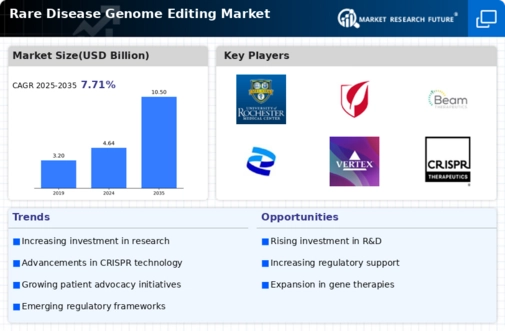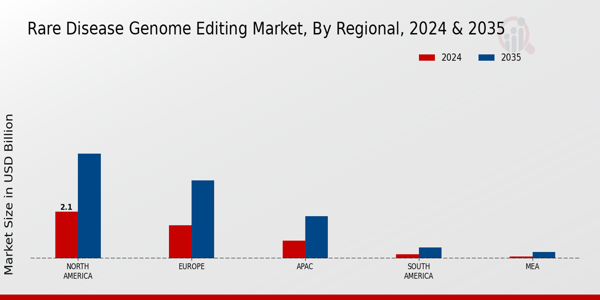Market Growth Projections
The Global Rare Disease Genome Editing Market Industry is poised for robust growth in the coming years. Projections indicate that the market will reach 4.64 USD Billion in 2024, with an anticipated increase to 10.5 USD Billion by 2035. This growth trajectory suggests a compound annual growth rate of 7.71% from 2025 to 2035. Such figures reflect the increasing demand for innovative therapies and the ongoing advancements in genome editing technologies. The market's expansion is likely to be influenced by various factors, including rising prevalence of rare diseases, technological innovations, and supportive regulatory frameworks.
Supportive Regulatory Frameworks
Regulatory bodies worldwide are increasingly recognizing the potential of genome editing in treating rare diseases, which is fostering growth in the Global Rare Disease Genome Editing Market Industry. Initiatives aimed at expediting the approval process for innovative therapies, such as orphan drug designations and fast-track approvals, are encouraging pharmaceutical companies to invest in research and development. This supportive environment not only accelerates the introduction of new treatments but also enhances collaboration between regulatory agencies and industry stakeholders. As a result, the market is likely to experience a compound annual growth rate of 7.71% from 2025 to 2035, reflecting the positive impact of these regulatory advancements.
Rising Patient Advocacy and Awareness
The increasing involvement of patient advocacy groups in the rare disease sector is driving the Global Rare Disease Genome Editing Market Industry. These organizations play a pivotal role in raising awareness about rare diseases, promoting research funding, and influencing policy changes. Their efforts help to highlight the urgent need for effective treatments, thereby attracting attention from pharmaceutical companies and researchers. As patient advocacy continues to grow, it is likely to lead to more collaborative initiatives aimed at developing genome editing therapies. This heightened awareness may contribute to the market's expansion, potentially reaching 4.64 USD Billion in 2024.
Increasing Prevalence of Rare Diseases
The rising incidence of rare diseases globally is a crucial driver for the Global Rare Disease Genome Editing Market Industry. As more than 7,000 rare diseases affect approximately 400 million people worldwide, the demand for innovative treatments is escalating. This growing patient population necessitates advancements in genome editing technologies, which can potentially provide targeted therapies. The increasing awareness and diagnosis of these conditions further contribute to market growth, as healthcare providers and researchers seek effective solutions. The market is projected to reach 4.64 USD Billion in 2024, reflecting the urgency to address these unmet medical needs.
Advancements in Genome Editing Technologies
Technological innovations in genome editing, such as CRISPR-Cas9 and TALENs, are propelling the Global Rare Disease Genome Editing Market Industry forward. These cutting-edge techniques enable precise modifications to DNA, offering new avenues for treating genetic disorders. The ability to edit genes with high accuracy and efficiency enhances the potential for developing therapies that can alter the course of rare diseases. As research institutions and biotech companies invest in these technologies, the market is expected to grow significantly. By 2035, the market could expand to 10.5 USD Billion, driven by the continuous evolution of genome editing methodologies.
Growing Investment in Rare Disease Research
The surge in funding for rare disease research is a significant driver of the Global Rare Disease Genome Editing Market Industry. Governments, non-profit organizations, and private investors are increasingly allocating resources to support the development of therapies for rare conditions. This influx of capital enables researchers to explore innovative genome editing solutions, fostering collaborations between academia and industry. As a result, the market is poised for substantial growth, with projections indicating a potential market size of 10.5 USD Billion by 2035. This investment trend underscores the commitment to addressing the challenges posed by rare diseases and advancing therapeutic options.















